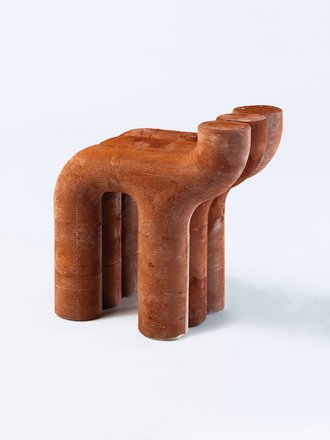Julia Huhnholz and Friedrich Gerlach Are Runners-Up for the James Dyson Award 2023 in Germany
With their joint Bachelor’s thesis on a type of low-emission biocement entitled »The Essence of Biocement«, the two Produktdesign (Product Design) alumni of the Bauhaus-Universität Weimar have reached the international selection round of the renowned James Dyson Award as runners-up in the Germany-wide competition. Each year, the competition calls on innovative students and recent graduates of product and industrial design and engineering degree programs worldwide to submit pioneering projects.
The task posed by the competition is to »Develop something that solves a problem.« It is important that the solution is effective and demonstrates sophisticated design thought. The final project of the designer duo fulfils both criteria. On the one hand, the biocement produced by Huhnholz and Gerlach themselves represents a serious alternative to conventional cement by preventing the release of immense amounts of CO2 emissions. On the other hand, the two succeed in illustrating the diverse uses of the still relatively unknown building material by means of the unique design language of the resulting piece of furniture.
The production of conventional cement is both energy and resource intensive. In order to make the solution of biocement better known and to demonstrate the diverse application possibilities, Julia Huhnholz and Friedrich Gerlach designed the seating furniture »The Essence of Biocement« and manufactured a prototype from the material. Through the use of urea, biocement can be produced on a microbial basis without a burning process. The bacteria contained in the mix bind the recycled bricks with the calcium carbonate and into a resilient and stable biocement. Sand, an increasingly scarce raw material that is normally used for biocement, can also be completely dispensed with in the production process developed by the young designers.
For their final thesis, Huhnholz and Gerlach had interdisciplinary cooperation partners at their side: the Faculty of Civil Engineering at the Bauhaus-Universität Weimar, the Institute of Microbiology at Friedrich Schiller University Jena and the civil engineers at the University of Cape Town.
Further information and a video about »The Essence of Biocement« can be found here: https://www.friedrichgerlach.de/the-essence-of-biocement
About the competition
Having been honoured as a runner-up entry, »The Essence of Biocement« will automatically participate in the international competition. A jury of experts at the national level first evaluates the submissions. In each of the participating countries, one national winning project and two national runners-up are selected. From these winners, a jury of Dyson engineers then selects a shortlist of the best 20 entries internationally. The top 20 projects are then reviewed by James Dyson, who selects the winning project, the runners-up and the Sustainability Winner at the international level. The national first-place winners and the runners-up at the international level each receive 5,700 euros. The prize money for the international winning project is 34,000 euros.
»The Essence of Biocement« was supervised by Dr Jan Willmann, Professor of Theory and History of Design, Katrin Krupka, then Acting Professor of Material and Environment, and Scientific Associate Michael Braun, Professor of Theory and History of Design.
If you have any questions, please do not hesitate to contact Romy Weinhold, Press and Public Relations Officer at the Faculty of Art and Design, by telephone at +49 / 36 43 / 58 11 86 or by e-mail at romy.weinhold[at]uni-weimar.de.
Kontakt
Bauhaus-Universität Weimar
Claudia Weinreich
Pressesprecherin
Tel.: +49(0)3643/58 11 73
Luise Ziegler
Mitarbeiterin Medienarbeit
Tel.: +49(0)3643/58 11 80
Fax: +49(0)3643/58 11 72
E-Mail: presse[at]uni-weimar.de
Web: www.uni-weimar.de/medienservice




